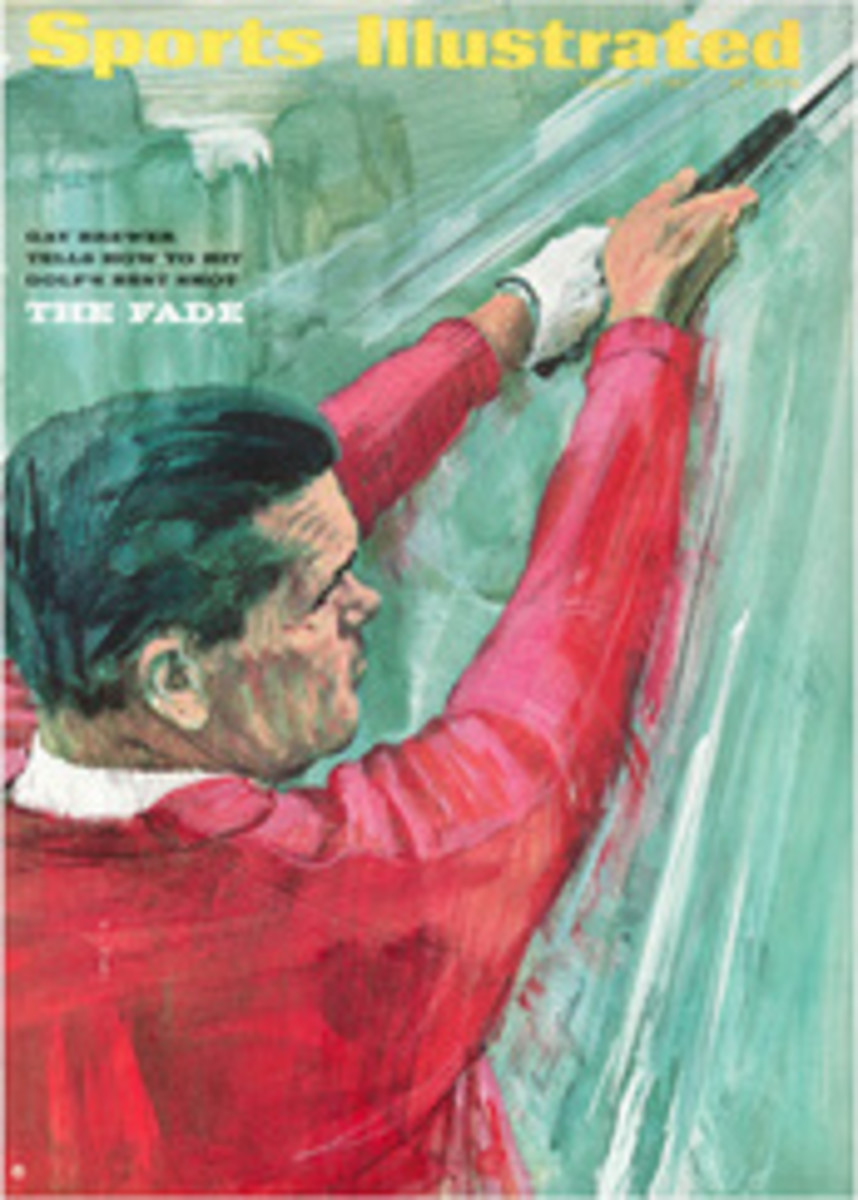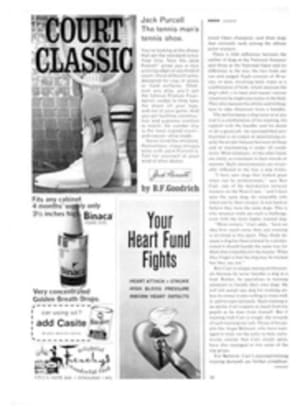
How to Avoid Boredom with a Modified Choke
For many years I never held a gun in my hand or felt any desire to. Then I found myself married to an Englishman who talked shooting and hunting from August to February and who dragged me with him to sit away long weekends in stately homes and chat with nonshooting nannies and mums while he and the other men bagged hares and grouse on heathered moors.
After some seven years of this I decided the time had come to take Annie Oakley seriously. So I went to visit Mr. Lyell. Mr. Lyell is the manager of Holland & Holland of Bruton Street, rifle-makers to Prince Philip. As soon as I sat down in his office, Mr. Lyell showed me a photograph of the Prince holding one Holland & Holland gun and a photograph of another made for an Indian maharaja with a replica of the Taj Mahal engraved on its stock. I hurriedly explained that while I did indeed have every hope of following these royal examples I thought I'd better find out if I could fire a gun before I bought one. No trouble at all. We could, said Mr. Lyell, arrange a series of six private lessons (for $38, plus the cost of shells and clay targets) for me at the Holland & Holland shooting school, 13 miles from London. There, he said, on 70 acres of beautiful country, lie 15 shooting stands where clay birds are thrown to simulate partridge, pheasant, driven grouse and flighting duck. On the principle that no one could resist such delights I signed up for the course.
The following morning at 8:30 a plum-colored station wagon drove me to the school. My instructor, a Mr. Norman Clarke, greeted me, wearing a knickerbocker suit in brown-checked tweed, and began my lesson with advice on appropriate shooting dress: "Never wear a loud color that might startle the birds or distract the other shooters," he said (I was in a bright-red windbreaker). "Plus-fours are still worn here by the men," he added. "The ladies wear tweed suits, comfortable shoes with studs, and small-brimmed mackintosh hats." I had on corduroy trousers, Wellington boots and a scarf.
Having scored zero on attire, I was ushered into a small school building surrounded by rose gardens in brilliant bloom, and handed my first gun. Right then, before I had even started, I despaired. I couldn't tell you its weight, but I'd as soon find fun in pushing a bulldozer uphill as in carrying that gun for a day on the moors. "This is our try gun," said Mr. Clarke. "Of course, it's heavier than a shotgun." He smiled, having noticed my palsied arms. "We use it to fit you. It will be adjusted in nine different ways for your arm length, the shape of your shoulder and, most importantly, your eyesight. When I've worked with a pupil and find he's missing consistently in the same way, I know his gun has insufficient cast-off—I think you call that offset in the U.S. Anyone whose gun isn't a perfect fit is handicapping his shooting ability. Your gun should compensate for any personal physical weakness, and you should have it checked every year. I've got a man who comes out for lessons whose stock has been shortened from 14¾ to 12‚⅛ over the years as his muscles contracted. He's 84 now and still shooting well."
As we walked along the footpath across the open field to the fitting plate at which I would fire my first shot (from the lightest gun in the shop—28 bore), Mr. Clarke was careful to show me how he carried his gun over one arm, unloaded and with the breech open. I'd had mine up on my shoulder like the guards at Buckingham Palace.
"Now, the first thing you do," he said when we reached the plate, "is to look through the barrel and see if it's empty. Then you take your stance: left toe at 12 o'clock, right toe at 2 o'clock, with four to six inches between the heels. If your stance is too wide you'll drop a shoulder while crossing birds. Then balance the gun between your hands: the left hand under the barrel with the thumb around the grip and the pad of the first finger resting on the trigger guard ready to squeeze the trigger. You don't want to squeeze with the joint instead of the pad of that finger or you'll be in for bruised fingers. Now, mounting that gun correctly is very important. You're holding the gun in any comfortable and safe position and you see a bird. Keep your eyes on that bird and bring the gun up so that the stock pauses for a second under the right armpit. Now, forget the gun completely. Your eyes must be riveted on the bird! This will compel you to keep your head still—so that the stock of the gun is allowed to come to the correct place against your shoulder and check. Don't incline your cheek to the gun, but bring the gun right up to your cheek. If you do this your shoulder will meet the gun. Never put the gun to your shoulder. If you are looking at the bird your left hand will automatically point at it, and if you bring the gun up to your cheek your shoulder will meet it. Once you've learned the correct gun mounting, the barrel end will take care of itself. All you have to do is keep your eyes on the bird."
"Now mount your gun!" I checked my stance. O.K. Left hand under, thumb right, fingers left, right thumb on the grip. O.K., up. The stock rested under my right armpit. "Now, forget the gun!" shouted Mr. Clarke. I forgot my gun—and a second later ended my first mounting with my head twisted sideways and straining down right to meet the stock that was still stuck under my armpit!
On my second lesson I was allowed to load the gun. "No! Don't push the cartridge in. Drop it in; let it take itself in. Look first to make sure there's nothing in there. It's easy to drop in a smaller shell—say, one your child dropped in your cartridge bag. Then you put in another, thinking, 'Funny, thought I just put one in,' and you fire and blow off your hand." Pretty funny, all right, I thought. But my instructor was speaking again. "When you close the gun bring the stock up to the barrels—not the other way round."
A few moments later we were aiming at "driven partridge," which still remarkably resembled clay pigeons. "Here," said Clarke, "you have to start from behind the bird. He's coming right over you. Look at the tail. Move your eyes up to its beak. You'll think you're in front of it—shoot! That's it! Move up on it. Good."
Oh, I thought, this is fun! Shooting is fun!
"No. You stopped your gun. Keep moving. Fire as you get to the beak, but let the gun follow through. No! [Shooting's a bloody waste of time!] Try again. Keep your eyes on the bird. Good! [Oh, shooting is great]."
I shot about 40 rounds at the "partridge," and to Mr. Clarke's delight I hit every "bird" when I did exactly what he had said. As we walked back to the central building Mr. Clarke discussed boring—how "full choke" means a close boring, giving you a nine-inch diameter of shot at 20 yards and how "cylinder" is open boring and gives 20 inches diameter at 20 yards, and how the ideal game boring is improved cylinder in the right barrel and modified choke in the left, and how, if you are shooting driven grouse, you want improved cylinder in both barrels, and how, if it's wild fowl you're after, you have to have three-quarters in the left and full choke in the right. All perfectly clear—like binary mathematics.
"In the grouse butt, Jack!" Mr. Clarke called out to the bent old trapper who hobbled off to "pull" for my third lesson. It was a beautiful, clear, sunny day, and we had to wait between shots for a tractor to turn the hay for drying in the field where we stood. The school's land is farmed by a neighbor, and in rainy England "make hay while the sun shines" is no figure of speech. At last, however, the fun began. The birds were released from eight different positions, singly and in pairs. Expecting one bird to the right, I would get two to my left. The shock made me jump, and then the gun would bounce. My left arm got weak and wobbly.
"Even the best shooters have to get that left arm in shape before the season," said Mr. Clarke. "After all, if you are right-handed your left arm doesn't do much during the year. You can't expect it to suddenly get strong when fall rolls around." (I made a vow to use my left arm for everything I could from then on. The vow stuck for three days and cost me two cups, one plate, two cigarette burns and one spilled martini.)
For my fourth lesson we moved to the tower.
"I want you to remember that shotgun shooting is instinctive shooting. These birds are coming from what seems far away. Keep both eyes on the bird, and don't take a second go. Shoot when your gun reaches your cheek at the moment you're on the beak. A high bird looks farther away than he is. Your eyes will deceive you, but you'll miss him if you wait."
He was right. I waited, and I missed.
For my last two lessons I was given another instructor, Mr. C. G. Potter, who has been teaching since 1932. He is older than Mr. Clarke (68 is a guess). He is bent with rheumatism, and his large hands are swollen with arthritis. All that Mr. Clarke had said he reiterated, so that my confidence in what I had already learned remained intact. I learned in addition that I tended to shift my weight and that my weight should remain slightly on the ball of my right foot. I also learned from Mr. Potter that the lighter the gun the more chance of recoil. This surprised me at first, but he explained that a heavier stock would naturally absorb more recoil. Mr. Potter's hearing has been affected after years of shooting, and he recommended earplugs for use during lessons. "You need your ears open, though, when you're waiting for a real bird."
So now my ears are open and ringing with such admonitions as, "Keep your eyes on the bird!" "Don't check the gun when you pull the trigger!" "Follow through to the beak!" "Don't look at the gun!" "Keep your head still!" and, "Point at the bird with your left arm!"
I may not bag my limit this fall, but with any luck I won't shoot a ghillie or a duke, and I reckon (as the British say) that with a brushup lesson or two before the season, a spiffy new tweed suit, a new pair of oxfords with studs, a Robin Hood hat, and a properly cast-off gun I should be all right, Jack. I'm sure, after all these years of urging me to shoot, my husband will be delighted. Let's see: that's $38 for lessons to date, about $35 for the shells, say $20 for brushup classes, $90 for the suit, $50 for the jacket, $10 for a hat, $27 for shoes and a made-to-order gun for only $2,750—yes, he'll be delighted.

